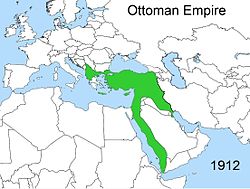Ottoman Empire: Difference between revisions
Jump to navigation
Jump to search
m (added modreview template) |
(Removing plagiarized content) Tag: Replaced |
||
| Line 1: | Line 1: | ||
{{infobox country | {{infobox country | ||
|common_name = Ottoman Empire | |common_name = Ottoman Empire | ||
| Line 28: | Line 27: | ||
==History== | ==History== | ||
After these many defeats, the Ottoman Empire suffered many revolts from groups across the Empire. Mainlt Arabas and Balkan Nations influenced by Great Powers,the Ottomans struggled to deal with these rebellions and many broke off to form nations of their own giving the Ottomans the borders they have today. | |||
After these many defeats, the Ottoman Empire suffered many revolts from groups across the Empire. Mainlt Arabas and Balkan Nations influenced by Great Powers,the Ottomans struggled to deal with these rebellions and many broke off to form nations of their own giving the Ottomans the borders they have today | |||
==Politics== | ==Politics== | ||
==Geography== | ==Geography== | ||
==Foreign Relations== | ==Foreign Relations== | ||
Revision as of 18:10, 25 February 2021
The Sublime Ottoman Empire Osmanlı İmparatorluğu | |
|---|---|
Motto: The Eternal State | |
 | |
| Capital | Constantinople |
| Official languages | Turkish |
| Recognised national languages | Kurdish, Arabic, Persian, Greek, Armenian |
| Religion | Islam |
| Demonym(s) | Ottoman |
| Government | Absolute Monarchy |
• Sultan | Mahmud II |
• Grand Vizier | Benderli Ali Pasha |
| Legislature | General Assembly |
| Chamber of Notables | |
| Chamber of Deputies | |
| Population | |
• 1820 estimate | 25,230,660 |
| Currency | Sultani |
The Ottoman Empire is a nation in the Middle East. It comprises regions of Anatolia, Mesopotamia and Syria, the Balkans, and Arabian Peninsula. It is an absolute monarchy with the current sultan being Mahmud II.
History
After these many defeats, the Ottoman Empire suffered many revolts from groups across the Empire. Mainlt Arabas and Balkan Nations influenced by Great Powers,the Ottomans struggled to deal with these rebellions and many broke off to form nations of their own giving the Ottomans the borders they have today.

